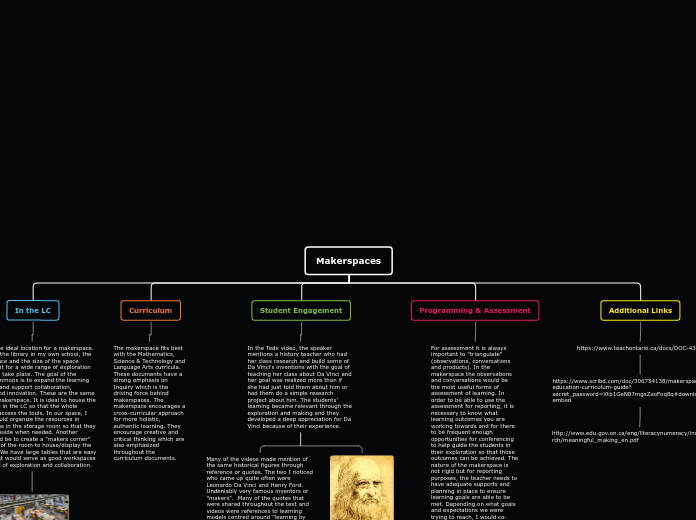Makerspaces
Additional Links
https://www.teachontario.ca/docs/DOC-4307
https://www.scribd.com/doc/306754138/makerspace-for-education-curriculum-guide?secret_password=Xtb1GeN87mgxZaoFoq8q#download&from_embed
http://www.edu.gov.on.ca/eng/literacynumeracy/inspire/research/meaningful_making_en.pdf
Programming & Assessment
For assessment it is always important to "triangulate" (observations, conversations and products). In the makerspace the observations and conversations would be the most useful forms of assessment of learning. In order to be able to use the assessment for reporting, it is necessary to know what learning outcomes you are working towards and for there to be frequent enough opportunities for conferencing to help guide the students in their exploration so that those outcomes can be achieved. The nature of the makerspace is not rigid but for reporting purposes, the teacher needs to have adequate supports and planning in place to ensure learning goals are able to be met. Depending on what goals and expectations we were trying to reach, I would co-create general success criteria that is liberal enough to avoid stifling creativity but clear enough to help students focus their attention and time constructively.
Student Engagement
In the Tedx video, the speaker mentions a history teacher who had her class research and build some of Da Vinci's inventions with the goal of teaching her class about Da Vinci and her goal was realized more than if she had just told them about him or had them do a simple research project about him. The students' learning became relevant through the exploration and making and they developed a deep appreciation for Da Vinci because of their experience.
Many of the videos made mention of the same historical figures through reference or quotes. The two I noticed who came up quite often were Leonardo Da Vinci and Henry Ford. Undeniably very famous inventors or "makers". Many of the quotes that were shared throughout the text and videos were references to learning models centred around "learning by doing". Students are more engaged in their learning because the very nature of it is to be engaged - they are physically DOING and MAKING - they are fully implicated in the task and in their learning. I know this is absolutely is an engaging way of learning for all.
Curriculum
The makerspace fits best with the Mathematics, Science & Technology and Language Arts curricula. These documents have a strong emphasis on Inquiry which is the driving force behind makerspaces. The makerspace encourages a cross-curricular approach for more holistic, authentic learning. They encourage creative and critical thinking which are also emphasized throughout the curriculum documents.
In the LC
The LC is the ideal location for a makerspace. Thinking of the library in my own school, the physical space and the size of the space would permit for a wide range of exploration and work to take place. The goal of the learning commons is to expand the learning experience and support collaboration, creativity and innovation. These are the same goals of a makerspace. It is ideal to house the makerspace in the LC so that the whole school can access the tools. In our space, I think we could organize the resources in movable bins in the storage room so that they can be put aside when needed. Another option would be to create a "makers corner" in one area of the room to house/display the resources. We have large tables that are easy to move that would serve as good workspaces for this kind of exploration and collaboration.

